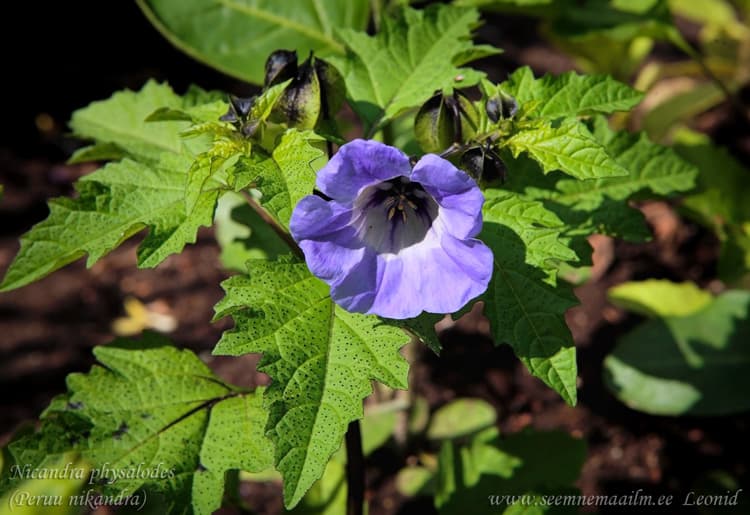This amazing annual plant was brought to Europe from Peru. The plant is still rare.
It is named so for the shape of its fruits, similar to the fruits of physalis. This is a tall powerful plant with branched stems up to 100 cm high. The diameter of a flowering plant reaches 80 cm. Large goblet flowers with a diameter of about 3 cm are pure blue in color.
Fruits, like "Chinese lanterns", hang on branches. Especially decorative garden form with dark green leaves and anthocyanin petioles and stems.

Location: Shoofly plant is very thermophilic and drought-resistant. It grows well on any soil, but prefers fertile and sunny places, without requiring special care.
Reproduction: seeds. In 1 g there are 700 - 800 pieces. To obtain 100 plants, 0.5 g of seeds are sown in the first half of April. Shoots appear in 7-9 days. Hardened seedlings are planted in the ground after the end of spring frosts at a distance of 45-50 cm from each other.
Nicandra blooms in July and blooms until frost.
Use: Shoofly plant can be planted to decorate walls and fences, it is especially good as single plants or in small groups on the lawn, near the terrace or porch. Branches with fruits cut in autumn before frost are perfectly dried and used in winter, dry bouquets and compositions.
During flowering, it is strewn with blue bell flowers, and after flowering, seed "lantern boxes" appear on it, which look very original on the bush.
Cut and dried branches effectively complement the bouquet of dried flowers.
An interesting feature is the fact that after the first wave of flowering, Shoofly plant gives a lot of side shoots (stepchildren), on which flowers reappear. And the flowers continue until frost...
Shoofly plant looks beautiful both in single and in group plantings.
However, the dignity of nikandra lies not only in its decorative qualities, but also in the fact that it is a medicinal plant: stems, leaves, flowers and fruits are used for medicinal purposes.
"Apple of Peru" prefers to grow in well-lit sunny places. She is heat-loving, although at the same time cold-resistant. It grows and develops better on fertile, humus-rich soils. In the care is absolutely undemanding.
Seeds of Niсandra physaloides are sown immediately into the ground in mid-May: seedlings appear within a week.
Seedlings tolerate transplantation well (it should be borne in mind that the plants grow strongly in breadth: by 80-90 cm, so the distance between them should be from 1 to 1.5 m.
Eng.: Apple of Peru, shoofly plant. Suom.: Perunkoiso, rakkokoiso. Sven.: Ballongblomma, leanderblomma, leanderklocka. Bot. syn.: Atropa physalodes L., Physalodes physalodes (L.)











